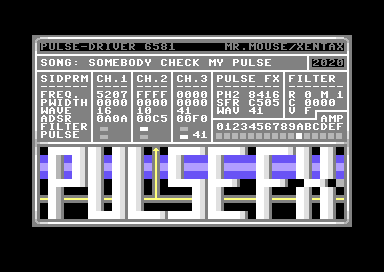|
| |
|
Somebody Check My Pulse [2020] |
Credits :
SIDs used in this release :
Download :
Look for downloads on external sites:
Pokefinder.org
Summary
Submitted by Mr. Mouse on 21 October 2020
Summary
Submitted by Mr. Mouse on 18 October 2020
An example of the waveform you can create by just flipping gate on/off in a certain frequency with ADSR 00F0 is this.
 |
Summary
Submitted by Mr. Mouse on 18 October 2020
PULSE-DRIVER 6581
=================
Using gate on/off in note frequency, adds PULSE-FX to SID sounds.
Taken from the assembly file:
;================================================================
;
; Voice x waveform bits :
; 0 (1) $01 Gate bit
; 1 (2) $02 Sync Osc x with Osc y
; 2 (4) $04 Ring Mod Osc x with Osc y
; 3 (8) $08 Test Bit: disable Osc x
; 4 (16) $10 Triangle waveform ($90 pulse)
; 5 (32) $20 Sawtooth waveform ($a0 pulse)
; 6 (64) $40 Pulse waveform ($c0 pulse)
; 7 (128) $80 Noise waveform
;
; Waveform and Pulse note commands (on voice 3:
;
; 00-7f - No change, no pulse
; 80-87 - No change
; 89 - Noise + pulse
; 8b - Noise + pulse and frequency of noise audible
; 90-cf - bit 7: pulse note (bit 7), otherwise wave forms as above
; - bit 3: set frequency of standard waveform as well (otherwise will be set to 0)
; d1-df - special presets (reserved)
;
; D1 set pulse waveform to $80 and fix noise frequency at $ffff, while allowing pulse frequency to change
; D2 set pulse waveform to $10 and fix at current frequency, while allowing pulse frequency to change
; D3 set pulse waveform to $20 and fix at current frequency, while allowing pulse frequency to change
; D4 set pulse waveform to $40 and fix at current frequency, while allowing pulse frequency to change
; D5 set pulse waveform to $10 and fix pulse at current frequency, while allowing waveform frequency to change
; D6 set pulse waveform to $20 and fix pulse at current frequency, while allowing waveform frequency to change
; D7 set pulse waveform to $40 and fix pulse at current frequency, while allowing waveform frequency to change
;
;======================VOICE PULSE INSTRUMENT ===============================
; Effects:
;
; Sharpness:
; To change the sharpness of the waveform resulting from gate on/off pulse notes, the sustain level can be used
; Sustain of $f is the loudest, deeper, and more full bodied, with a small plateau when declining from the max attack phase (with 0 decay)
; On the other hand, the waveform is more like a saw tooth (more like sharp sharkfin) when using low sustain levels.
; So in essence, sustain of 0 is the sharpest and the full body and loudness increases all the way up to max sustain of $f.
;
;
; Filters can be used as normal, in a way, but note there is some grainy effect on the overall sound.
; Filter resonance can be used to make a pulse sound louder, at the cost of more graininess. So, resonance of 15 is loudest (depending on filter pass settings), but most grainy.
;
; Changes to Release corrupt the waveform, the release should be set to 0, so it reaches 0 at the fastest rate when gate is turned off.
; Changes to Attack are pretty useless. The only value other than 0 that is audible is 1, basically lowering the frequency of the peeks.
; Changes to Decay cause immediate issues as well, and has to be kept at 0 as well.
;
; To boost amplitude, performing the pulse on multiple channels at the same time can be done: the frequency of voice 3 is leading!
; note that the lower frequencies of the pulse take longer to complete and may delay the next frame of the SID settings !
The PULSE-FX can be used on any channel, however the priority is channel 1<channel 2<channel 3.
So, if we wish to use a standard PULSE FX on CH1, and CH3 also has a PULSE FX frequency, CH1 will have the PULSE FX frequency of CH3. |
|
|
|
 | Search CSDb |
|
 | Navigate |  |
|
 | Detailed Info |  |
|
 | Fun Stuff |  |
· Goofs
· Hidden Parts
· Trivia
|
|
 | Forum |  |
|
 | Info on other sites |  |
|
 | Support CSDb |  |
|
 |  |
|



